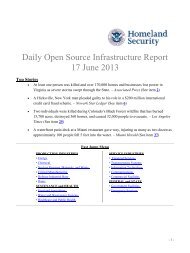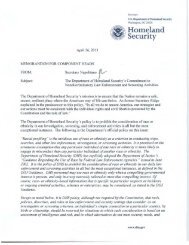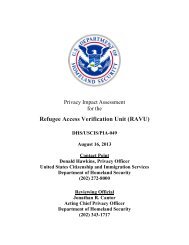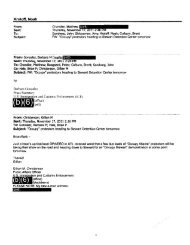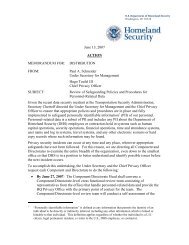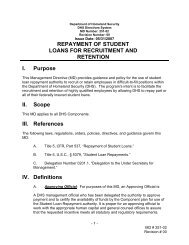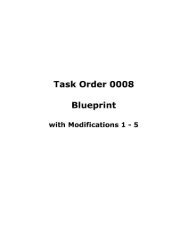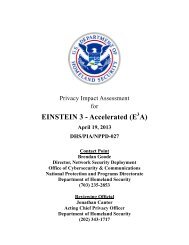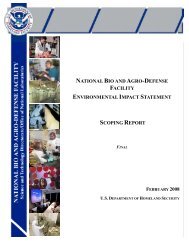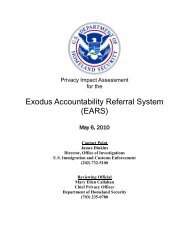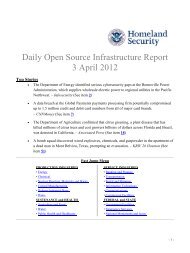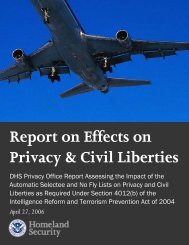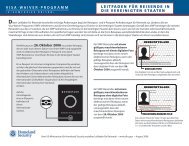Banking and Finance Sector-Specific Plan - U.S. Department of ...
Banking and Finance Sector-Specific Plan - U.S. Department of ...
Banking and Finance Sector-Specific Plan - U.S. Department of ...
Create successful ePaper yourself
Turn your PDF publications into a flip-book with our unique Google optimized e-Paper software.
system. All <strong>of</strong> the systemically critical institutions are subject to some form <strong>of</strong> Government oversight, <strong>and</strong> their resilience is a<br />
matter <strong>of</strong> keen interest. As technology <strong>and</strong> innovation advance the operations <strong>of</strong> financial services firms, the list <strong>of</strong> systemically<br />
critical institutions may evolve over time.<br />
There are also institutions or groups <strong>of</strong> institutions that, while not systemically critical, play significant roles in critical financial<br />
markets. Consequences <strong>of</strong> disruption at these organizations would vary. For example, an operational disruption at the largest<br />
banks <strong>and</strong> firms with significant payment or market activities could be tolerated for a limited time, while disruptions at others<br />
may be tolerated for longer periods, especially if their operations could be shifted or performed by other market participants.<br />
After September 11, 2001, the securities markets <strong>and</strong> several futures exchanges were closed until telecommunications <strong>and</strong> other<br />
services were restored to lower Manhattan. The fact that these markets <strong>and</strong> new transactions were affected for a short period <strong>of</strong><br />
time did not result in significant damage to or loss <strong>of</strong> confidence in the U.S. financial system.<br />
Diversity within the financial services sector <strong>and</strong> geographic dispersion <strong>of</strong> its institutions lend significant resilience to the<br />
<strong>Banking</strong> <strong>and</strong> <strong>Finance</strong> <strong>Sector</strong>. In addition to the systemically critical institutions described above, the U.S. financial system<br />
consists <strong>of</strong> many thous<strong>and</strong>s <strong>of</strong> depository institutions, securities <strong>and</strong> futures firms, insurance companies, <strong>and</strong> other financial<br />
service companies, <strong>and</strong> supports a number <strong>of</strong> exchanges <strong>and</strong> over-the-counter markets, all <strong>of</strong> which provide a high degree<br />
<strong>of</strong> redundancy across the sector. The competitive structure <strong>of</strong> the financial industry <strong>and</strong> the breadth <strong>of</strong> the financial instruments<br />
provide a level <strong>of</strong> resiliency against attack <strong>and</strong> other types <strong>of</strong> physical or cyber disruptions. Accordingly, for purposes <strong>of</strong><br />
determining systemic vulnerabilities, these institutions, while certainly important to the financial system, are not considered<br />
systemically critical.<br />
2.1 Defining Information Parameters<br />
The <strong>Banking</strong> <strong>and</strong> <strong>Finance</strong> <strong>Sector</strong> may be divided into several functions: deposit <strong>and</strong> payments systems; credit <strong>and</strong> liquidity<br />
products; investment products; <strong>and</strong> risk transfer products. Various members <strong>of</strong> the FBIIC regulate each <strong>of</strong> these functions as<br />
outlined in section 1.1. The financial regulators, through their oversight authority, obtain a vast amount <strong>of</strong> information on<br />
institutions, critical assets <strong>and</strong> processes, <strong>and</strong> potential vulnerabilities. <strong>Sector</strong>-wide risks assessments are process-driven <strong>and</strong><br />
address interdependence. Individual institutions also conduct their own risk assessments to identify <strong>and</strong> mitigate internal vulnerabilities<br />
<strong>and</strong> external dependencies.<br />
The Treasury <strong>Department</strong>, through collaboration <strong>and</strong> insights obtained from the members <strong>of</strong> the FBIIC <strong>and</strong> the FSSCC, gathers<br />
sector-specific information. Although the definition <strong>of</strong> asset data is limited to the categories collected by the regulators, regulatory<br />
examinations <strong>and</strong> trade association surveys are thorough <strong>and</strong> provide adequate information for defining financial assets.<br />
General information for assets may include as appropriate to each component <strong>of</strong> the sector:<br />
• Asset name, mailing address, physical location, owner/operator name;<br />
• Function or type <strong>of</strong> transaction: deposit <strong>and</strong> payments systems; credit <strong>and</strong> liquidity products, including investment <strong>and</strong> risk<br />
transfer;<br />
• Geographic region, financial center;<br />
• Number <strong>of</strong> employees;<br />
• Economic contribution: total market value <strong>of</strong> financial transactions conducted by or through the asset on a daily, weekly,<br />
monthly, <strong>and</strong> yearly basis;<br />
• International considerations, if any;<br />
• Existing <strong>and</strong> planned protective measures;<br />
<strong>Banking</strong> <strong>and</strong> <strong>Finance</strong> <strong>Sector</strong>-<strong>Specific</strong> <strong>Plan</strong>



